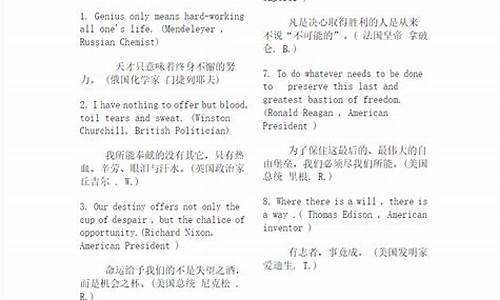英文基本句子结构_英语句子的基本结构缩写是
1.英语基本语法结构详解
2.英语句子基本格式是什么?
3.英语句子成分
4.英语句子成分的英文表示方法及缩写
5.英语中的S、V、P分别代表的是什么意思?

根据结构划分一共是5中句子结构。
简单句
1.主谓结构
S+V
2主谓宾结构
S+V+O
3.主系表结构
S+V+P
4.主谓
间宾
直宾
S+V+o+O
5.主谓宾+宾补
S+V+O+S
并列句and
but
or
复合句:名词从句(宾主表同)·状语从句·定语从句
英语基本语法结构详解
现代汉语句子成分名称(主语、谓语、宾语、定语、状语、补语等)的英文缩写,分列如下:
1、主语是“S”,是英语单词Subject第一个字母的大写。
2、谓语是“Pred”,是英语单词predicate的前四个字母,其中第一个字母大写,其它三个字母是小写。
3、宾语是“O”,是英语单词Object第一个字母的大写。其中直接宾语是DO,间接宾语INO。
4、定语是(Att),是英语单词Attribute前面的三个字母,其中第一个字母是大写,后面两个字母是小写。
5、状语是“A”,是英语单词Adverblal第一个字母的大写。
6、补语是“C”,是英语单词Complement的第一个字母的大写。
值得注意的是,现代汉语句子成分的英文缩写,与英语句子成分的缩写多数是相同的,只有谓语不相同。英语谓语的缩写是“V”,是英语单词Verb(动词)的第一个字母大写。
英语句子基本格式是什么?
英语基本语法结构详解
英语语法是针对英语语言进行研究后,英语语法系统地总结归纳出来的一系列语言规则。英语语法的精髓在于掌握语言的使用。以下是我整理的关于英语基本语法结构详解,希望大家认真阅读!
英语词性缩写
n = 名词,noun的缩写
u = 不可数名词,uncountable noun的缩写
c = 可数名词,countable noun的.缩写
v = 动词, verb的缩写
vi = 不及物动词,intransitive verb的缩写
vt = 及物动词,transitive verb的缩写
aux.v = 助动词 ,auxiliary verb的缩写
model verb情态动词
conj = 连接词 ,conjunction的缩写
adj. = 形容词,adjective的缩写
adv.= 副词,adverb的缩写
art. = 冠词,article的缩写
prep = 介词;preposition的缩写
pron = 代名词,pronoun的缩写
num = 数词,numeral的缩写
int. = 感叹词,interjection的缩写
英文基本句式介绍: 五个基本句式可以演变出多种复杂的英语句子。这五个基本句式如下:
S十V主谓结构
S十V十P主系表结构
S十V十O主谓宾结构
S十V十O1十O2 主谓双宾结构
S十V十O十C 主谓宾补结构
(说明:S=主语;V=谓语;P=表语;O=宾语;O1=间接宾语;O2=直接宾语;C=补语)
1.S十V
在此句式中,V是不及物动词,又叫自动词(vi.)。例如:
He runs quickly.他跑得快。
They listened carefully.他们听得很仔细。
He suffered from cold and hunger.他挨冻受饿。
China belongs to the third world country.中国属于第三世界国家。
The gas has given out.煤气用完了。
My ink has run out.我的钢笔水用完了。
2.S十V十P
在此句式中,V是系动词(link v.),常见的系动词有:look,seem,ear,sound,feel,taste,smell,grow,get,fall ill/asleep,stand/sit still,become,turn等。例如:
He is older than he looks.他比看上去要老。
He seen interested in the book.他似乎对这本书感兴趣。
The story sounds interesting.这个故事听起来有趣。
The desk feels hard.书桌摸起来很硬。
The cake tastes nice.饼尝起来很香。
The flowers smell sweet and nice.花闻起来香甜。
You he grown taller than before.你长得比以前高了。
He has suddenly fallen ill.他突然病倒了。
He stood quite still.他静静地站看。
He becomes a teacher when he grew up.他长大后当了教师。
He could never turn traitor to his country.他永远不会背叛他的祖国。
3.S十V十O
在此句式中,V是及物动词(vt.),因此有宾语。例如:
I saw a film yesterday.我昨天看了一部**。
He you read the story?你读过这个故事吗?
They found their home easily.他们很容易找到他们的家。
They built a house last year.他们去年建了一所房子。
They‘ve put up a factory in the village.他们在村里建了一座工厂。
They he taken good care of the children.这些孩子他们照看得很好。
You should look after your children well.你应该好好照看你的孩子。
4.S十V十O1十O2
在此句式中,V是带有双宾语的及物动词。常见的须带双宾语的动词有give,ask,bring,offer,send,pay,lend,show,tell,buy,get;rob,warn等。例如:
He ge me a book/a book to me.他给我一本书。
He brought me a pen/a pen to me.他带给我一枝钢笔。
He offered me his seat/his seat to me.他把座位让给我。
注意下边动词改写后介词的变化:
Mother bought me a book/a book for me.妈妈给我买了一本书。
He got me a chair/a chair for me.他给我弄了一把椅子。
Please do me a for/a for for me.请帮我一下。
He asked me a question/a question of me.他问我个问题。
注意,下边动词只有一种说法:
They robbed the old man of his money.他们抢了老人的钱。
He’s warned me of the danger.他警告我注意危险。
The doctor has cured him of his disease.医生治好了他的病。
We must rid the house of the rats.我们必须赶走屋里的老鼠。
They deprived him of his right to speak.他们剥夺了他说话的权利。
5.S十V十O十C
在此句式中,V是有宾语补足语的及物动词。常带宾语补足语的词有形容词、副词、介词短语、名词、不定式、现在分词、过去分词,请看下面的例子。
They made the girl angry.他们使这个女孩生气了。
They found her hy that day.他们发现那天她很高兴。
I found him out.我发现他出去了。
I saw him in.我见他在家。
They saw a foot mark in the sand.他们发现沙地上有脚印。
They named the boy Charlie.他们给这个男孩起名为查理。
I saw him come in and go out.我见他进来又出去。
They felt the car moving fast.他们感到汽车行驶得很快。
I heard the glass broken just now.我刚才听到玻璃碎了。
;英语句子成分
1、肯定句:是指用肯定的语气来陈述的句子,如:
I’m a student. She is a doctor. He works in a hospital.
There are four fans in our classroom.
I’m going to buy a comic book tonight. He will eat lunch at 12:00.
I’m reading a book. They are swimming.
I watched TV yesterday evening.
2、否定句:含有否定词或表示否定意义词的句子,如:
I’m not a student. She is not (isn’t) a doctor.
He does not (doesn’t) work in a hospital.
There are not four fans in our classroom.
I’m not going to buy a comic book tonight.
He will not (won’t) eat lunch at 12:00.
I’m not reading a book. They are not (aren’t) swimming.
I did not (didn’t) watch TV yesterday evening.
☆注意☆ 小结:否定句主要是在肯定句的基础上加上了否定词 “not”。有动词be的句子则“not”加在be后面,可缩写成“isn’t,aren’t”,但am not 一般都分开写。没有动词be的句子则要先在主要动词的前面加上一个助动词(do,does,did),然后在它后面加上“not”,你也可以把它们缩写在一起如“don’t , doesn’t , didn’t )。这三个助动词要根据人称和时态来选择,其中“does”只用于一般现在时主语是第三人称单数的情况,而“did”只用于一般过去时,不论主语是什么人称和数,都用“did” 。
3、一般疑问句:是指询问事实的句子,此类句子必须用“yes”,或“no”来回答。如:Are you a student? Yes, I am / No, I’m not.
Is she a doctor? Yes, she is. / No, she isn’t.
Does he work in a hospital? Yes, he does. / No, he doesn’t.
Are there four fans in our classroom? Yes, there are. / No, there aren’t.
Are you going to buy a comic book tonight?
Yes, I am. / No, I am not. (Yes, we are. / No, we aren’t.)
Will he eat lunch at 12:00? Yes, I will. / No, I will not(won’t).
Are you reading a book? Yes, I am. / No, I am not.
Are they swimming? Yes, they are. / No, they aren’t.
Did you watch TV yesterday evening? Yes, I did. / No, I didn’t.
☆注意☆ 小结:一般疑问句是在肯定句的基础上,
①把动词be调到首位,其他照写,末尾标点符号变成问号即可。
②没有动词be的句子则要在句首加上一个助动词(do,does,did)再把紧跟在后面的动词变回原形,末尾标点符号变成问号即可。
这三个助动词也要根据人称和时态来选择,其中“does”只用于一般现在时主语是第三人称单数的情况,而“did”只用于一般过去时,不论主语是什么人称和数,都用“did” 。一般疑问句有个重要的原则就是问和答要一致,即问句里的第一个单词(助动词)和简略答句里的这个词是一致的。
4、特殊疑问句:以特殊疑问词(what , where , who , which , when , whose , why , how等)开头引导的句子。此类句子应该问什么就答什么,不能用“yes 、no”来回答。如:
What is this? It’s a computer.
What does he do? He’s a doctor.
Where are you going? I’m going to Beijing.
Who played football with you yesterday afternoon? Mike.
Which season do you like best? Summer.
When do you usually get up? I usually get up at 6:30.
Whose skirt is this? It’s Amy’s.
Why do you like spring best? Because I can plant trees.
How are you? I’m fine. / I’m hy.
How did you go to Xinjiang? I went to Xinjiang by train.
☆其中how又可以和其他一些形容词连用组成特殊疑问词组用来提问,如: how many(多少(数量)), how much(多少(钱)), how tall(多高), how long(多长), how big(多大), how hey(多重)
例句:How many pencils do you he? I he three pencils.
How many girls can you see? I can see four girls.
How many desks are there in your classroom? There are 51.
☆小结:how many 用来提问可数名词的数量,主要有以上三种句式搭配,
How many + 名词复数 + do you he? 你有多少……?
How many + 名词复数 + can you see? 你能看见多少……?
How many + 名词复数 + are there…? 有多少……?
英语句子成分的英文表示方法及缩写
prep = 介系词;前置词,preposition的缩写
pron = 代名词,pronoun的缩写
n = 名词,noun的缩写
v = 动词,兼指及物动词和不及物动词,verb的缩写
conj = 连接词 ,conjunction的缩写
s = 主词
sc = 主词补语
o = 受词
oc = 受词补语
vi = 不及物动词,intransitive verb的缩写
vt = 及物动词,transitive verb的缩写
aux.v = 助动词 ,auxiliary的缩写
a = 形容词,adjective的缩写
ad = 副词,adverb的缩写
art = 冠词,article的缩写
num = 数词,numeral的缩写
int = 感叹词,interjection的缩写
u = 不可数名词,uncountable noun的缩写
c = 可数名词,countable noun的缩写
pl = 复数,plural的缩写
语气词 int.
缩写词 abbr.
英语中的S、V、P分别代表的是什么意思?
subject主语
object宾语
predicate谓语
predicative表语
attribute定语
adverbial状语
object complement宾语补足语
predicative表语
够不够?
S是subject的缩写,意思是主语;V是verb的缩写,意思是谓语;P是predicative,意思是表语。
一、主语:是谓语讲述的对象,一般由名词、代词、不定代词、从句、动名词等来充当,句子叙述的主体,一般位于句首。
如:She likes dancing.
她喜欢跳舞。
二、谓语:说明主语是什么,做什么或怎么样,由动词充当,主语和谓语在人称和数上要保持一致,谓语动词存在多种时态,谓语是句子的核心。
如:He is very handsome.
他非常帅。
三、表语,现代英语中已经不用表语这个概念了。因为表语属于主语补语,表语前面用系动词,主语补语前面除了系动词之外,还可以是不及物动词。
举例来说,在句子He is a teacher中,a teacher 既是表语也是主语补语。但是在句子He fell down injured中,injured是主语补语,但不是表语,因为fell down不是系动词。
扩展资料
主系表型(S+Link. V+P)
即“主语+系动词+表语”结构,这种句型主要用来表示主语的特点、身份等。其中的“系”是指系动词(link verb),“表”是指表语(predicative),系动词和表语连用的结果经常被称作系表结构。如:The ice cream tastes delicious.
1、Our school is not far from my home.
is 为系动词作谓语,用一般现在时。far 为形容词作表语。our, my 为形容词型物主代词。
2、Cleaning the house needs a lot of time.
Cleaning 为动名词,在句中作主语。needs 为谓语,用一般现在时。动词用第三人称单数形式。the 为定冠词。
声明:本站所有文章资源内容,如无特殊说明或标注,均为采集网络资源。如若本站内容侵犯了原著者的合法权益,可联系本站删除。












